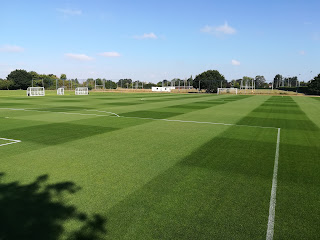Let There Be Light!
Grow lights have been a valuable tool in stadiums over the last 15 years and we have been adding rigs to the Portman Rd since 2013, with our latest addition in November.
Having done much research across the three main manufacturers to get the best value for money, we decided to purchase a new LU120 from SGL. We also looked at TLS and MLR which would have also done a good job for us.
TLS offered the same SqM coverage but with 18 bulbs to the SGL 24 and MLR offered two rigs with 12 in each rig covering 160SqM.
The MLR option was of interest to us as we could split the two rigs up if necessary, covering 80SqM each. although the light intensity was diluted more over the extra 40SqM, I believe it would have been adequate to maintain grass coverage where we needed it.
MLR are reviewing the design and build of this rig and when this has happened, I will be very interested in looking again and believe they will become very competitive in the grow lights market.
 |
| LU120 |
Every season the area in front of the dugouts loses a large percentage of grass coverage. The main reasons for this is lack of light, poorer soils in that area and increased foot traffic during games because of where it is. The LU120 is now positioned in this area and the expectation is that we will retain considerably more grass. We have already noticed that the light, with 1000w bulbs in dries the soil out a lot more quickly than the 600w MU360 which is based further along the wing.
The pitch cover was used for the first time this season at the end of November for the Bristol City game to keep the 11mm of rain which fell off the pitch the night before the game. This did reduce our time we had to work on the pitch to turn it around from the Sky game on the previous Friday, but better that way and manage the rainfall.
We are fortunate in Ipswich to get half of the average rainfall for the UK, but it doesn't feel like it sometimes! In November, we had 25% more than our average but below overage over the previous 6 months, so it was time for natures payback...
During the Autumn, we usually suffered from, what I believe is called "Ghost Grass". I understand that it something to do with the plant not being able to control the production of gibberellic acid, therefore promoting growth. this is possibly some sort of fungal infection. The plant leaves are soft (probably due to cell elongation) and they do not get cut when the pitch is cut with a cylinder mower. The only way to remove them is cutting with a rotary mower.
During the Autumn, we usually suffered from, what I believe is called "Ghost Grass". I understand that it something to do with the plant not being able to control the production of gibberellic acid, therefore promoting growth. this is possibly some sort of fungal infection. The plant leaves are soft (probably due to cell elongation) and they do not get cut when the pitch is cut with a cylinder mower. The only way to remove them is cutting with a rotary mower.
 |
| Ghost grass on 3 of the training pitches |
Now that that the soil temperatures have dropped, we are currently at about 7 deg, the pitches have slowed in growth considerably and we are only cutting to present for matches and a tidy up when required. it is noticeable the extra growth under the stadium grow lights though, and showing a more dense plant.
It goes to show how important the grow lights are, however many are owned, we always need more to maintain grass coverage in the high wear areas. We are now in our sixth year of not turfing the goal mouths at the stadium, which we will endeavour to continue this record through the season.













































